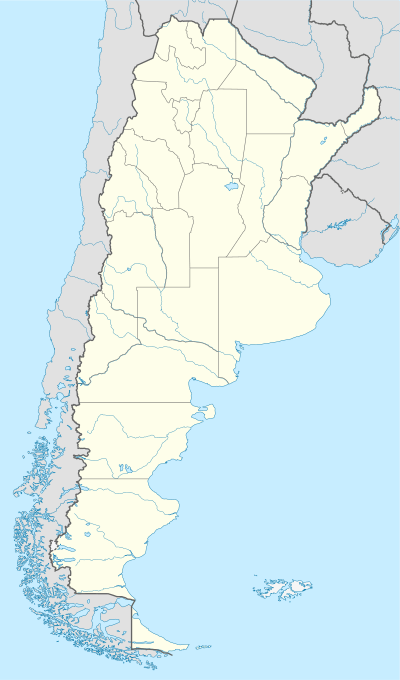Teniente General Benjamín Matienzo International Airport
| Teniente General Benjamín Matienzo International Airport Aeropuerto Internacional Teniente General Benjamín Matienzo | |||||||||||
|---|---|---|---|---|---|---|---|---|---|---|---|
|
| |||||||||||
| Summary | |||||||||||
| Airport type | Public | ||||||||||
| Operator | Government and Aeropuertos Argentina 2000 | ||||||||||
| Serves | San Miguel de Tucumán | ||||||||||
| Location | Ruta A016 Km9. (T4117) CEVIL POZO | ||||||||||
| Elevation AMSL | 1,495 ft / 456 m | ||||||||||
| Coordinates | 26°50′27″S 065°06′17″W / 26.84083°S 65.10472°WCoordinates: 26°50′27″S 065°06′17″W / 26.84083°S 65.10472°W | ||||||||||
| Map | |||||||||||
 TUC Location of airport in Argentina | |||||||||||
| Runways | |||||||||||
| |||||||||||
| Statistics (2017) | |||||||||||
| |||||||||||
|
Source: [1] | |||||||||||
Teniente General Benjamín Matienzo International Airport (IATA: TUC, ICAO: SANT) is an international airport located 12 kilometres (7.5 mi) from the city of San Miguel de Tucumán. It serves Tucumán Province in the north of Argentina. It was built in 1981, and its terminal was inaugurated on 12 October 1986. The airport provides four departure gates, two arrival gates, immigration and passenger services, plus a large cargo terminal, the second biggest in the country.
Overview
This airport replaced the old one, located on the Ninth of July Park, because of its bad location (650 metres (2,133 ft) from the Plaza Independencia), and the lack of space for expansions, plus noise restrictions and the risks of having an airport in the very city centre The old airport had just one short runway 17/35 of (1600 m/5000 ft) and it was closed in 1987. Now the Bus Main Station uses parts of the apron of the airport, while the Music School from the Universidad Nacional de Tucumán uses its passenger terminal.
The Departing Sector was rebuilt in 2005, with international flights facilities and a jet bridge. It can all kind of aircraft, such as the Boeing 747, Boeing 767, Airbus A330 or Boeing 777.
It has 135,000 m² of runways, 21,250 m² of taxiways, a 6,985 m² terminal, two hangars of 1,840 m², and parking places for 278 cars. It has a small cargo terminal of 50 m². Cargo flights are important as Tucumán is the second-most important airport in Argentina in order of tons of cargo (after Buenos Aires-Ezeiza). Most cargo flights are scheduled between September and November, taking fresh fruit to Europe and the United States. A freight terminal was constructed in 2013.
In 1988, it handled 710,000 passengers. In 1998, 568,000. And in 2008, just 287,000 passengers. Traffic is growing: 193,000 passengers in 2007; 287,000 in 2008; 365,000 in 2009; 411,000 in 2010; 404,000 in 2011; 445.000 in 2012; 500.906 in 2013; and 523.191 in 2014
On 9 April 2013, the runway heading changed from 01/19 to 02/20 due to magnetic variation. Due to runway reconstruction and prolongation to 3500m, the airport was closed between June and September 2017. The runway was expanded from 2,900m to the actual 3,500m, making it the second longest in Argentina, after the one of Río Gallegos.
Airlines and destinations
Passenger
Cargo
| Airlines | Destinations |
|---|---|
| Atlas Air | Miami, FL |
| Centurion Air Cargo | Austin, TX |
| LAN Cargo | Lima, Los Angeles, Miami |
Statistics
| Passengers | Change from previous year | Aircraft operations | Change from previous year | Cargo (metric tons) | Change from previous year | |
|---|---|---|---|---|---|---|
| 2011 | 404,040 | 6,007 | 4,937 | |||
| 2012 | 444,893 | 5,655 | 5,167 | |||
| 2013 | 500,906 | 6,099 | 3,427 | |||
| 2014 | 523,191 | 5,538 | 5,950 | |||
| Source: ORSNA | ||||||
Ground transportation
Tucumán International Airport has direct public transport links to San Miguel de Tucumán served by Bus nº 121 to the Bus Terminal Station, through AV. Avellaneda. Route A016 (continuation from Av. Sarmiento) provides access to the City Center. Taxis and rental cars are available as well, as is the case in most airports.
References
- ↑ En vivo desde TUC [@aeropuertotuc] (19 August 2017). "IMPRESIONANTE: Con ustedes, la nueva pista de aterrizaje de Tucumán. Con sus 3.500 metros de largo, es ahora la más…" (Tweet) – via Twitter.
- ↑ 2017, UBM (UK) Ltd. "Aerolineas Argentinas Adds Domestic Service for Cordoba / Mar del Plata in 2016". AirlineRoute.net. Retrieved 24 December 2017.
- ↑ 2017, UBM (UK) Ltd. "LATAM Brasil adds Sao Paulo – Tucuman from June 2018". RoutesOnline.com. Retrieved 24 December 2017.
- 1 2 "LATAM volará desde Santiago a Tucumán, San Juan y Neuquén, ofreciendo la mayor conectividad entre Chile y Argentina". www.Desdescl.com. Retrieved 24 December 2017.